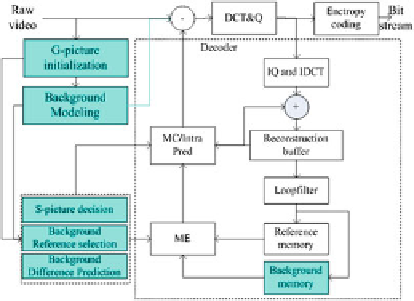Game Development Reference
In-Depth Information
Fig. 8.8
Video codec
architecture of AVS2
surveillance coding. In this
figure, white modules are the
common tools for general
video coding, and others are
for surveillance video coding
To well support such above method and accomplish a high-efficiency video codec,
Fig.
8.8
shows the architecture. In this architecture, six additional modules compared
with common codecs are marked. G-picture is initialized by G-picture initialization
and updated by Background Modeling with methods such as median filtering, etc.
In such way, the selected or generated G-picture can well represent the background
of a scene with seldom or even no occluding foreground objects and noise. Once
a G-picture is obtained and encoded, the reconstructed picture will be stored into
the Background Memory in encoder/decoder and updated only if a new G-picture is
selected or generated. After that, S-picture can be involved in the encoding process
by S-picture Decision. Only with G-picture as reference, the S-picture owns similar
utilities as traditional I-picture, such as error resilience and randomaccess. Therefore,
the pictures which should be coded as traditional I-pictures are candidate S-pictures,
such as the first picture of one GOP, scene change frame, etc. To accomplish a fast
random access and error resilience, only intra, SKIP and INTER 2
N
×
2
N
modes
with zero motion vectors are available for S-picture coding.
In the AVS2 committee draft (CD) text, G and GB picture types are defined
to identify the extension concept of background picture, scene picture, wherein
GB is a nonoutput G-picture usually generated or modeled from training frames.
As shown from Fig.
8.9
, AVS2 CD text utilizes flags of
scene
_
picture
_
fla
g
and
scene
_
picture
_
out put
_
fla
g
to define the G and GB picture types. GB picture
differs from G-picture by
scene
_
picture
_
out put
_
fla
g
=
0.
Secondly, In AVS2 CD text, the S-picture which only utilizes G or GB picture
for zero motion prediction is defined by the syntax
scene
_
pr ed
_
fla
g
signaled in
inter prediction
_
picture
header, as shown in Fig.
8.10
.
Under the control of G/GB and S-pictures, AVS2 surveillance coding can well
support the random access in both video archive system and video transmission
system. In the former system, when random accessing one S frame, the G/GB picture
can be quickly obtained by backtracking the stream. After decoding the G/GB picture
referenced by the S-picture, the random access S-picture is decoded. In the latter
system, by utilizing the DASH transmission mechanism in AVS2 system part, for

